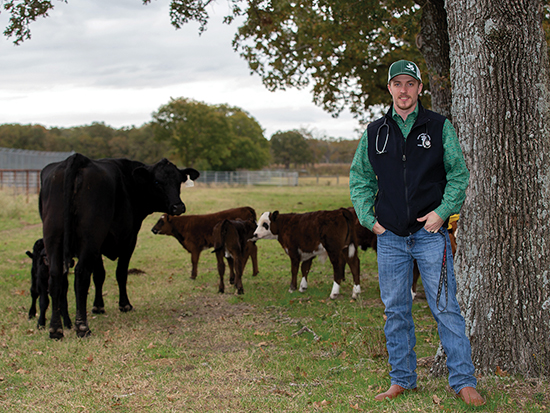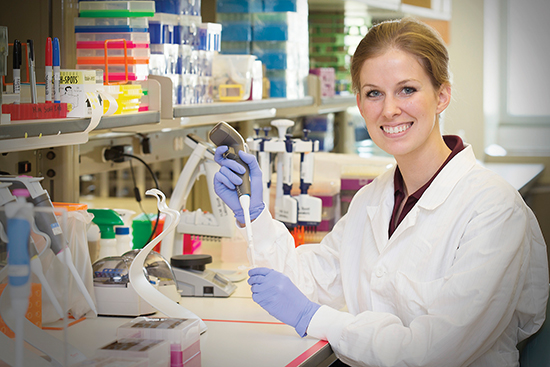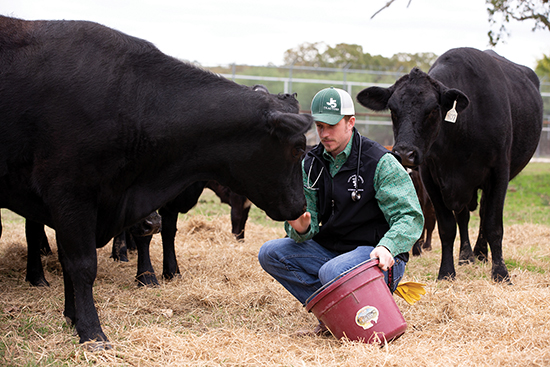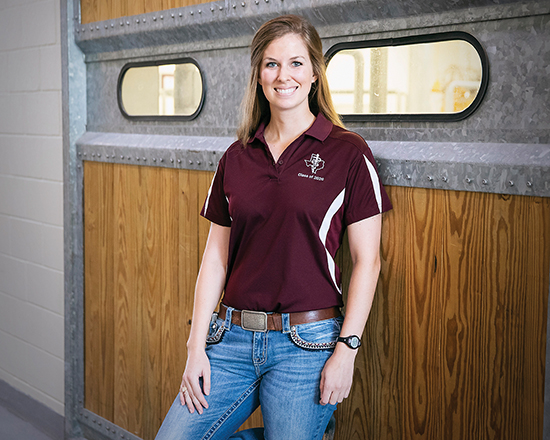Countryside Care
Story by Dorian Martin

Kale Johnson and Elizabeth Lake come from opposite ends of the spectrum.
Johnson, who hails from a rural community with a population of less than 2,200 in the Texas Panhandle, grew up around a variety of livestock. In comparison, Lake, who was raised in the heart of Dallas, primarily spent her early years around dogs and horses.
However, both fourth-year students are now committed to joining the ranks of rural veterinarians.
This is important because the U.S. Department of Agriculture reports that 500 U.S. counties, many rural, were underserved by veterinarians in 2019. Forty-four states reported shortages, which is the largest number since tracking began.
Taking The Macro View
Lake initially wasn’t interested in veterinary medicine; instead, she considered law or policy.
“Despite always loving animals and people always asking me if I wanted to be a veterinarian, I just didn’t see myself doing that,” she said. “But then in college, I actually took an epidemiology class and a veterinarian came and talked about public health and the One Health idea in general. That lecture got me thinking, ‘OK, there’s so much more you can do with a veterinary degree.’”
After earning an undergraduate degree in human biology with a minor in political science and a master’s degree in environmental science from Stanford University, Lake decided to apply to veterinary school.
“Texas A&M was always a top choice, just because I’m a proud Texan,” she said. “I’ve always been a huge Aggie fan my whole life, and A&M’s really strong in the areas that I’m interested in: large animal, especially food animal medicine, and One Health.”

She hasn’t been disappointed in her decision. Lake points to her summer research fellowship with the CVM’s Dr. Morgan Scott and Dr. Keri Norman, during which she explored how antimicrobials are being used in production settings to affect resistance patterns and bacteria such as Salmonella and Campylobacter.
She also participated in a rural internship program through the CVM and West Texas A&M’s Veterinary Education, Research, & Outreach (VERO) program, during which she explored the clinical challenges of a rural mixed animal practice and worked with dairy veterinarians.
“I was really impressed by the quality of medicine that was practiced out there,” Lake said. “A lot of times we think when you’re dealing with limited budgets, limited resources, and limited abilities to refer, you’re really handcuffed medically. To some extent that’s true, but I still didn’t feel at all that patients were getting a lower quality of care. I was, by any standards, highly impressed with how dedicated those veterinarians are to continuing their education and to offering outstanding services to their communities.”
Lake will start her veterinary career at a mixed animal practice in central Texas that serves a large town and surrounding rural communities.
“I’m looking forward to the case variety of a true mixed animal practice and to building relationships with my hospital team and the communities that are trusting us with the care of their animals,” she said.
She one day hopes to use her breadth of knowledge in veterinary medicine, environmental science, and human biology to get involved in policy decisions.
“There’s an increasing focus on how we’re managing herds. That’s not necessarily a veterinary-exclusive thing; that’s almost more of an animal science- or management-type deal. But there are still contributions that veterinarians can make to those types of discussions, obviously,” she said. “(And) anytime you’re treating a food animal, you’ve got human health in the back of your mind, too.”

Returning To A (Rural) Home
Johnson’s entire life has involved agriculture and livestock. His mother’s family raised stocker cattle while his father’s family focused on show cattle and ran a cow-calf operation. Johnson’s parents both competed in rodeo and worked for the Cargill plant in Saginaw.
Growing up in the small rural community of Idalou, Johnson’s interest in becoming a rural veterinarian was fostered through raising show animals and his interactions with his agriculture teachers, especially Wayne “Fud” Robertson and the late Danny Gunn, whom he said were tremendous influences on his drive to be a leader and give back to the FFA.
“Growing up in these smaller communities, very often the veterinarian was the most academically educated person in the community and that was something I admired,” he said. “People often came to them for things way outside the role of veterinary medicine. I want to be able to do that for other people as well.”
Now that he’s in veterinary school, Johnson has tried to make the most of his CVM experience.
“Showing up to class every day and doing the extra things were important to me,” he said. “I didn’t want to waste anything. I hate getting to the end of something and looking back and going, ’Well, I could’ve done a little bit more of this or that.’”
His time in the CVM also has been influenced by his wife, Elizabeth Ford-Johnson, who graduated from the CVM in 2015. The couple met when Johnson, an undergraduate, was assisting the CVM’s Dr. Juan Romano with a research project on Boer goats while his soon-to-be-wife, then a fourth-year student, was on a field service rotation.
“That’s not where I thought I’d meet my wife, in a stinky goat pen,” he said with a smile.

Over the years, Elizabeth has offered valuable advice to Johnson on how to navigate veterinary school.
“She’s my saving grace, because from day one, I had somebody who had just been through it,” he said. “Especially that first year, it’s really hard adjusting to that kind of study mentality. She warned me about classes like anatomy, physiology, and immunology, which are the ones that trip up a lot of students.”
After Johnson’s graduation, the couple will move to Louisburg, Kansas, where they have both been offered jobs at a rural practice.
“The thing that makes veterinary medicine so fun for me is the diversity. I very much want to dabble in a little bit of everything,” he said. “I like to have the ability to go out and palpate 200 cows in the morning, come back to a dog C-section at the middle of the day, and then go out and do some Coggins tests on some horses.”
Johnson also looks forward to becoming an integral part of a rural community.
“You know everybody by name; everyone waves at you going by,” he said. “These people need good veterinarians. They need someone they can depend upon in times of financial need, since these cattle are their livelihood. And then they need care for their pets as well, which are emotional animals for them. I feel a great need to serve in those areas.”
###
Note: This story originally appeared in the Spring 2020 edition of CVM Today.
For more information about the Texas A&M College of Veterinary Medicine & Biomedical Sciences, please visit our website at vetmed.tamu.edu or join us on Facebook, Instagram, and Twitter.
Contact Information: Jennifer Gauntt, Director of Communications, Texas A&M College of Veterinary Medicine & Biomedical Sciences; jgauntt@cvm.tamu.edu; 979-862-4216


